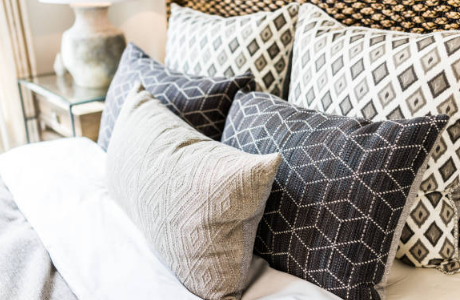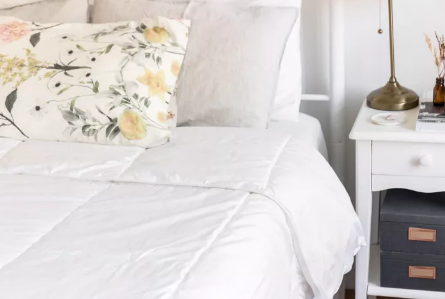
Is an Open Floor Plan Right for You? Pros, Cons, and 5 Things to Think About
July 28, 2025
What is a Murphy Bed? A Classic Space-Saving Solution.
August 4, 2025How you make your bed is ultimately a matter of personal preference, but there’s a unique way luxury hotel beds are made that sets them apart.
Here are some common mistakes that might be making your bed feel less like a five-star hotel and more like an average one.
1. Incorrectly Putting on the Fitted Sheet
If your fitted sheet won’t stay in place, it usually comes down to one of two reasons:
-
You’re putting it on wrong: Take a look at the backside of your fitted sheet. One of the corner pockets will have a tag stitched into the inner seam. For a perfect, secure fit, that tagged pocket should go on the bottom left corner of the mattress—left meaning the left side when you’re lying on your back.
-
The pocket depth is wrong: Mattresses vary in thickness, and so do fitted sheet pocket depths. If the sheet’s pocket depth doesn’t match your mattress, the corners will slip off easily, or the sheet will be too loose. Measure your mattress, pick a sheet with the right pocket depth, and ensure it fits snugly. You should also account for any extra thickness if you have a mattress topper.

2. Buying Low-Quality Sheets
The quality of your sheets can make or break your sleep experience. Here’s what you need to know for a restful night:
-
The 100% cotton rule: Cotton sheets are breathable and less prone to staining compared to synthetic fibers. Plus, they get softer with time. Satin weave sheets typically feel the softest to the touch.
-
Look at the thread count, not the ply: A high thread count doesn’t necessarily mean better quality cotton. The type of cotton is a better indicator of quality. The best options are Egyptian cotton, Pima cotton, and Supima cotton.
-
Temperature matters: Whether you sleep on a warm foam mattress or tend to sweat at night, cotton sheets keep you cool due to their natural moisture-wicking properties. However, if your cotton sheets don’t stay dry, try a cotton-lyocell blend—lyocell is an eco-friendly fiber known for its moisture-absorbing qualities.
-
Change your sheets weekly: Dirty sheets can make your bed feel uncomfortable. To stay fresh, change your sheets once a week. Other bedding items should be washed every two to three months.
3. Only Using a Duvet
If you only use a fitted sheet and duvet, you won’t have the flexibility to adjust your bedding temperature throughout the night. You might find yourself too hot with the duvet or too cold without it.
Consider layering your bed. Start by adding a sheet between you and the duvet. Be sure to tuck it in so it won’t shift while you sleep. Then, place a spare blanket at the foot of your bed, neatly folded, so it’s easy to pull out if you get cold during the night.

4. Tucking the Bedding in Too Tight
If your sheets are tucked in so tightly that your feet feel cramped, it’s not the most comfortable sleeping environment. While no one likes their bedding slipping off, don’t tuck it so tightly that it restricts movement. Leave a little bit of space or loosen up the bedding before getting into bed—your toes will thank you.
5. Not Taking Care of Your Pillows
When cleaning your bedding, don’t forget about your pillows—no luxury hotel would let its pillows smell bad.
Pillows collect dirt, oils, and bacteria (which can cause acne), as well as allergens that can trigger sneezing, asthma, and itchy eyes. Here’s how to keep them fresh:
-
Wash pillowcases weekly.
-
Protect all your pillows with dust-mite covers and wash them every few weeks. Pillowcases go on top of the dust-mite cover.
-
Wash pillows every two months. If you have decorative pillows that can’t be washed, consider replacing them.
-
Replace regularly cleaned pillows every three years or so.
6. Sharing a Blanket
Luxury hotel beds often have multiple blankets available—down comforters, lighter throws, and a third option tucked away in the closet.
Just because you share a bed doesn’t mean you have to share blankets. This way, you won’t have to deal with someone hogging the covers or find yourself too hot or too cold. Opt for separate blankets instead.



